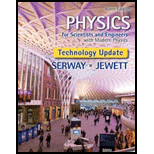
The change in fraction of the particles that are reflected changes as the barrier height is reduced to 2.01 eV .
Answer to Problem 1OQ
Option (b), It decreases.
Explanation of Solution
Write the expression for the transmission coefficient.
T≈e−2√2m(U−E)Lℏ (I)
Here, T is the transmission coefficient, m is the mass of the particle, U is the height of the potential barrier, E is the energy of the particles, ℏ is the reduced Planck’s constant and L is the width of the potential barrier.
Write the equation for the reflection coefficient.
R=1−T (II)
Here, R is the reflection coefficient.
When the barrier height is reduced, the difference between the barrier height and the energy of the particles decreases. According to equation (I), T increases with decrease in (U−E) . According to equation (II), with increase in transmission coefficient, reflection coefficient decreases.
Conclusion:
Since reflection coefficient decreases with decrease in potential barrier, option (b) is correct.
Since the reflection coefficient decreases with decrease in potential barrier, option (a) is incorrect.
Since the reflection coefficient changes with decrease in potential barrier, option (c) is incorrect.
Since the reflection coefficient changes with decrease in potential barrier, option (d) is incorrect.
Since the reflection coefficient changes with decrease in potential barrier, option (e) is incorrect.
Want to see more full solutions like this?
Chapter 41 Solutions
Physics for Scientists and Engineers with Modern Physics, Technology Update
- Did your experiment results in Data Table 3 verify, to within a reasonable experimental error, the condition of equilibrium of Equation 6: Στanti-clockwise = Στclockwise? Support your response with experimental data. What does this Σ mean? My results do not show they are equal to each other, what does this mean then, and what does the data show? Thanks!arrow_forwardmicro wave.arrow_forwardmicro wave.arrow_forward
- kerjakanarrow_forwardAn object is placed 37.4cm in front of a diverging lens with a focal length of 18.1 cm. Please provide your answers in units of cm if necessary. bookmark_border1.0p3a Find the image distance. Answer Updated 6 days ago Show feedback bookmark_border1.0p3b Is the image real or virtual? Real Virtual Updated 6 days ago Show feedback bookmark_border1.0p3c Suppose the object is brought to a distance of 10.3 cm in front of the lens. Where is the image now with respect to its previous location? (Note: Ensure the sign convention you use is consistent by treating all image distances on the object side of the lens as negative.) Answer Updated 7 minutes ago Show feedback bookmark_border1.0p3d How has the height of the image changed if the object is 84.2 cm tall? Answerarrow_forwardn object is placed 37.4cm in front of a diverging lens with a focal length of 18.1 cm. Please provide your answers in units of cm if necessary. bookmark_border1.0p3a Find the image distance. Answer Updated 6 days ago Show feedback bookmark_border1.0p3b Is the image real or virtual? Real Virtual Updated 6 days ago Show feedback bookmark_border1.0p3c Suppose the object is brought to a distance of 10.3 cm in front of the lens. Where is the image now with respect to its previous location? (Note: Ensure the sign convention you use is consistent by treating all image distances on the object side of the lens as negative.) Answer Updated just now Show feedback bookmark_border1.0p3d How has the height of the image changed if the object is 84.2 cm tall? Answerarrow_forward
- Can you draw a FBD and KD please!arrow_forwardIf a 120- volt circuit feeds four 40-watt fluorescent lamps, what current (in amps) is drawn if the power factor is 0.912 0.33 0.68 1.21 3.3arrow_forwardHow do you draw a diagram of the ruler and mass system in equilibrium identifying the anti-clockwise torque and clockwise torque? How do I calculate the anti-clockwise torque and the clockwise torque of the system with the ruler and the washers, does it come from the data in table 2? Please help, thank you!arrow_forward
 Principles of Physics: A Calculus-Based TextPhysicsISBN:9781133104261Author:Raymond A. Serway, John W. JewettPublisher:Cengage Learning
Principles of Physics: A Calculus-Based TextPhysicsISBN:9781133104261Author:Raymond A. Serway, John W. JewettPublisher:Cengage Learning University Physics Volume 3PhysicsISBN:9781938168185Author:William Moebs, Jeff SannyPublisher:OpenStax
University Physics Volume 3PhysicsISBN:9781938168185Author:William Moebs, Jeff SannyPublisher:OpenStax Physics for Scientists and Engineers with Modern ...PhysicsISBN:9781337553292Author:Raymond A. Serway, John W. JewettPublisher:Cengage Learning
Physics for Scientists and Engineers with Modern ...PhysicsISBN:9781337553292Author:Raymond A. Serway, John W. JewettPublisher:Cengage Learning Modern PhysicsPhysicsISBN:9781111794378Author:Raymond A. Serway, Clement J. Moses, Curt A. MoyerPublisher:Cengage Learning
Modern PhysicsPhysicsISBN:9781111794378Author:Raymond A. Serway, Clement J. Moses, Curt A. MoyerPublisher:Cengage Learning Glencoe Physics: Principles and Problems, Student...PhysicsISBN:9780078807213Author:Paul W. ZitzewitzPublisher:Glencoe/McGraw-Hill
Glencoe Physics: Principles and Problems, Student...PhysicsISBN:9780078807213Author:Paul W. ZitzewitzPublisher:Glencoe/McGraw-Hill College PhysicsPhysicsISBN:9781938168000Author:Paul Peter Urone, Roger HinrichsPublisher:OpenStax College
College PhysicsPhysicsISBN:9781938168000Author:Paul Peter Urone, Roger HinrichsPublisher:OpenStax College





